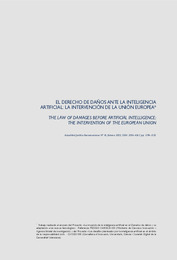Por favor, use este identificador para citar o enlazar este ítem:
https://hdl.handle.net/11000/31634Registro completo de metadatos
| Campo DC | Valor | Lengua/Idioma |
|---|---|---|
| dc.contributor.author | Ortiz Fernández, Manuel | - |
| dc.contributor.other | Departamentos de la UMH::Ciencia Jurídica | es_ES |
| dc.date.accessioned | 2024-03-01T11:25:47Z | - |
| dc.date.available | 2024-03-01T11:25:47Z | - |
| dc.date.created | 2023-02 | - |
| dc.identifier.citation | Actualidad Jurídica Iberoamericana Nº18, febrero 2023 | es_ES |
| dc.identifier.issn | 2386-4567 | - |
| dc.identifier.uri | https://hdl.handle.net/11000/31634 | - |
| dc.description.abstract | El avance de las tecnologías y, en su seno, la inteligencia artificial presenta retos en todos los sectores. En el ámbito jurídico, el encaje de los sistemas inteligentes no se presenta como una tarea sencilla. En este sentido, las notas presentes en los mismos (racionalidad, autonomía, incertidumbre, complejidad, etc.) no pueden predicarse de los productos que, hasta el momento, se utilizaban por los particulares. Todo ello, tiene incidencia directa en el Derecho de daños y afecta a muchos de sus elementos. El propio criterio de imputación, la determinación del nexo causal y la participación de una multiplicidad de sujetos, entre otras cuestiones, precisan de una solución adecuada. Precisamente por este motivo, las instituciones de la Unión Europea han ido emitiendo diferentes documentos en los que se reflexiona sobre todas estas disquisiciones. En el presente estudio, abordaremos el análisis del tratamiento ofrecido por dichas instituciones al tema de la responsabilidad civil y, en última instancia, las tendencias que, parece, se adoptarán finalmente | es_ES |
| dc.description.abstract | The advancement of technologies and, within them, artificial intelligence presents challenges in all sectors. In the legal field, the fit of intelligent systems is not presented as a simple task. In this sense, the notes present in them (rationality, autonomy, uncertainty, complexity, etc.) cannot be predicated on the products that, until now, were used by individuals. All this directly impacts the law of damages and affects many of its elements. The imputation criterion itself, the determination of the causal link and the participation of a diversity of subjects, among other issues, require an adequate solution. Precisely for this reason, the institutions of the European Union have been issuing different documents reflecting on all these disquisitions. In this study, we will address the analysis of the treatment offered by these institutions to the issue of civil liability and, ultimately, the trends that, it seems, will finally be adopted. | es_ES |
| dc.format | application/pdf | es_ES |
| dc.format.extent | 30 | es_ES |
| dc.language.iso | spa | es_ES |
| dc.publisher | IDIBE | es_ES |
| dc.rights | info:eu-repo/semantics/openAccess | es_ES |
| dc.rights | Attribution-NonCommercial-NoDerivatives 4.0 Internacional | * |
| dc.rights.uri | http://creativecommons.org/licenses/by-nc-nd/4.0/ | * |
| dc.subject | Autonomía | es_ES |
| dc.subject | inteligencia artificial | es_ES |
| dc.subject | racionalidad | es_ES |
| dc.subject | responsabilidad | es_ES |
| dc.subject | Unión Europea | es_ES |
| dc.subject | Autonomy | es_ES |
| dc.subject | artificial intelligence | es_ES |
| dc.subject | rationality | es_ES |
| dc.subject | liability | es_ES |
| dc.subject | European Union | es_ES |
| dc.subject.other | CDU::3 - Ciencias sociales::34 - Derecho | es_ES |
| dc.title | El derecho de daños ante la inteligencia artificial: la intervención de la unión europea | es_ES |
| dc.title.alternative | The law of damages before artificial intelligence: the intervention of the european union | es_ES |
| dc.type | info:eu-repo/semantics/article | es_ES |

Ver/Abrir:
7-AJI18_47.pdf
406,82 kB
Adobe PDF
Compartir:
 La licencia se describe como: Atribución-NonComercial-NoDerivada 4.0 Internacional.
La licencia se describe como: Atribución-NonComercial-NoDerivada 4.0 Internacional.
.png)